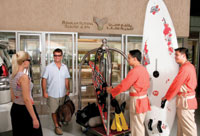
EVEN as the northern emirates of the UAE follow the lead of Dubai and Abu Dhabi with new real estate, aviation and hospitality projects, much of their success will come from a greater integration with the UAE.
While properties like the Kempinski Ajman – now 10 years old – have succeeded in marketing these destinations to the sun loving Europeans, much of the tourism business these emirates can expect comes from the weekend and short stay market, sourced from within the UAE itself, and from neighbouring Saudi Arabia.
And both categories of business depend on easy access to facilities in the better developed emirates, whether in terms of airports with more connections, like Dubai, or simply in terms of a day out to present and future cultural hotspots, such as Sharjah and Abu Dhabi respectively.
Without the help of the oil resources that have aided Abu Dhabi and Dubai, the other emirates are looking to real estate and hospitality to help develop their economies. The biggest challenge to sustained growth for the more remote of the northern emirates, then, is infrastructure development.
However, help is at hand, with plans underway to develop the UAE’s intercity connections. A long planned 350 km national railway network to link Ras Al Khaimah and Fujairah to Sharjah, Dubai and Abu Dhabi, is currently under development.
Last year, a reported 10 million commuters used intercity buses on 16 different routes and some 125 new buses will take to the roads this year, plying both within the UAE and into the wider GCC.
And in March this year, the UAE’s federal government announced a Dh16 billion ($4.4 billion) grant of federal funds for the northern emirates in a move to stimulate economic growth. The money, allocated following a federal study, is to be spent on developing infrastructure, transport and healthcare, besides other sectors.
The region will also benefit from an estimated expenditure of $15 billion by the Federal Electricity and Water Authority on increasing power and water supplies over the next decade. With Abu Dhabi, Dubai and Sharjah each running their own electricity and water utility service, the move will primarily benefit the Ras Al Khaimah, Ajman, Umm Al Quwain and Fujairah.
And it seems the investors agree. A survey by exhibition firm DSL Exhibitions, found that 85 per cent of respondents felt better integration with the more developed emirates would boost the development of these regions, while a similar number said that fast and frequent public transport, connecting northern emirates with its giant neighbours would significantly boost growth opportunities and development in the survey region. The DSL poll concerned lifestyle and developmental issues specific to Sharjah, Ajman, Umm Al Quwain, Fujairah and Ras Al Khaimah.
But the northern emirates continue to show a willingness to invest their own time and money in boosting tourism. Last year, the eastern coast witnessed the openings of the Fujairah Rotana Resort & Spa and JAL Fujairah Resort & Spa and the Hilton Resort & Spa Villas on the west coast. In the last 12 months, 23 new hotel project announcements were made in the northern emirates; Sharjah and Ras Al Khaimah were the most active, with nine and seven new projects respectively, according to TRI Hospitality Consulting.
The UAE’s GDP is estimated to have grown 16.5 per cent in 2007 to reach Dh698.1 billion ($190.1 billion), with real GDP expected to have grown by 7.4 per cent to reach Dh420.2 billion in 2007.
By Clark Kelly
